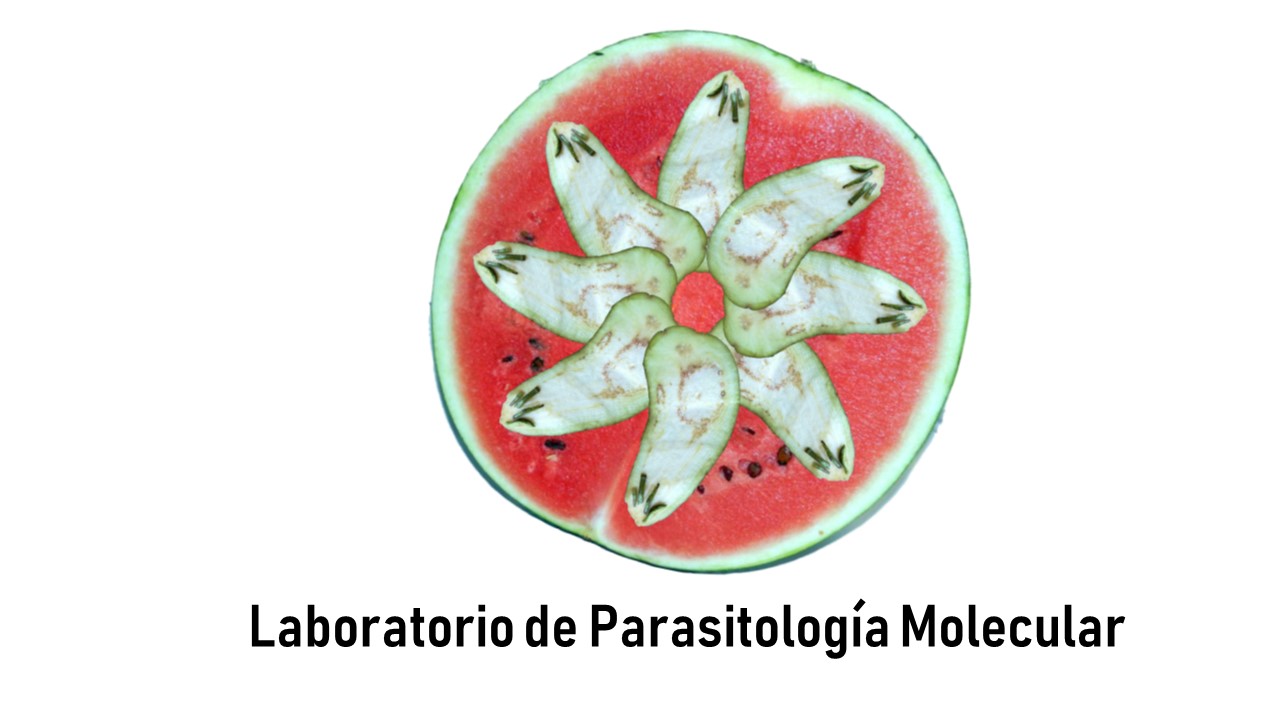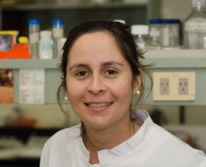Molecular Parasitology Laboratory

Head
- Sergio Angel, PhD - Principal Researcger CONICET. Full Professor UNSAM sangel@intech.gov.ar
Members
- Laura Vanagas, PhD - Assistant Researcher CONICET. Teaching Assistant UNSAM vanagas@intech.gov.ar

- Dr. Andrés Mariano Alonso- Investigador Asistente. Jefe de trabajos prácticos UNSAM amalonso@intech.gov.ar

- Constanza Cristaldi - Doctoral Fellow CONICET. Assistant UNSAM ccristaldi@intech.gov.ar

- Ayelén Aparicio Arias - Doctoral fellow ANPCyT aaparicio@intech.gov.ar
- Paula Formigo - Student of the University Technician in the UNSAM Laboratory pformigo@intech.gov.ar

- Leonardo Gualano Eng Posdoctoral Fellow Agencia I+D+i. Head of practical work leo.gualano@intech.gov.ar
Support Staff

- Agustina Ganuza Professional Techique CIC agusganuza@intech.gov.ar
Research Lines
Toxoplasma gondii is an obligate intracellular protozoan parasite which life cycle has a sexual phase that only occurs in the intestinal epithelium of felines (definitive host) and an asexual cycle that can occur in all the nucleated cells of mammals and birds. The distinctive characteristics of the asexual stage are two replicative forms, the rapid replicative tachyzoite and the bradyzoite, that replicates slowly and forms latent cysts in the tissues, mainly muscle and central nervous system. The symptoms due to toxoplasmic disease are associated with the presence of tachyzoites, while bradyzoites are related to chronic or latent infection, generally asymptomatic, although recent studies have stablished a relationship between the presence of anti-T. gondii antibodies and neurological disorders. The interconversion between tachyzoites and bradyzoites not only plays a fundamental role in the establishment of chronic disease, but is also responsible for the reactivation of the disease. Therefore, understanding the mechanisms that regulate the differentiation in the parasite is of great interest.
The Hsp90 molecular chaperone is one of the most conserved and abundant in eukaryotic organisms. The Hsp90 protein has diverse functions such as maturation, intracellular transport, transcription factors and protein kinases involved in signal transduction and the control of gene expression, cell cycle, apoptosis, etc. In our research group it was demonstrated that the Hsp90 protein of T. gondii is important for the differentiation of the parasite, and that its location depends on the stage in which the parasite is found: in tachyzoite it is in cytoplasm and in bradyzoite, in cytoplasm and nucleus. On the other hand, the Hsp90 protein forms several complexes, among them that of the Hsp70 / Hsp90 cycle, which is regulated by other proteins, the co-chaperones, that participate in an ordered series of dynamic multi-protein complexes connected with their ATPase cycle. Among them, the co-chaperone p23 and the chaperone of the Hsp40 family similar to Sis1, named TgSis1, were identified and characterized. We are currently analyzing the biological importance of the Hsp70 / Hsp90 cycle in T. gondii. For them we have obtained mutants of the chaperone of the Hsp40 family similar Ydj1 / Hdj2, called Tgj1, both by gene deletion and lacking the farnesylation motif. This protein would be important for the identification of the client protein within the cycle. We have also obtained mutants by deletion of the co-chaperone HOP, which relates to Hsp70 + client protein with Hsp90, a process that allows to bind the client protein to Hsp90 for its subsequent maturation. PP5 immunophilin bound to Hsp90 through its protein-protein binding domain called TPR1, is responsible for directing the Hsp90-heterocomplex to different subcellular locations, such as the nucleus. Mutants were also obtained by deletion of this gene.
During cell differentiation genes are turned on and off sequentially. Given the difficulty of finding a wide repertoire of transcription factors, it is believed that an important aspect in the regulation of the transcription of genes associated with development can be given by epigenetic mechanisms. Recently, in our research group we identified the presence of a variant for the H2B family (called H2Bv and later H2B.Z) in T. gondii. This aspect was of great interest since there are no variants of H2Bs in higher eukaryotes, except for some that are only expressed in gonads. Subsequently, it was observed that H2B.Z dimerizes specifically with H2A.Z and binds to active or bivalent promoters. In contrast, the canonical H2B histone of T. gondii (H2Ba) dimerizes and colocalizes with the histone H2A.X in silent sites of the genome and more especially in the subtelomeric region. Both histones, H2A.Z and H2B.Z are hyperacetylated at the N-terminal end while their canonical forms or the variant H2A.X are not. We are currently analyzing the role of these acetylations in the regulation of gene expression as well as in the tachyzoite to bradyzoite differentiation of T. gondii and in the modulation of the constitutive heterochromatin.
In eukaryotes there are basically two mechanisms for the repair of double strand breaks (DSB) in DNA well characterized in mammals and yeast: homologous recombination repair (HRR) and non-homologous end joining (NHEJ), although it has been described recently a variant to the NHEJ, called alternative NHEJ (a-NHEJ). The NHEJ mechanism occurs throughout the cell cycle and is considered to be more prone to errors since it joins two proximal DNA ends with little or no processing, although depending on the type of injury and the circumstances the NHEJ can be very precise. On the other hand, the HRR mechanism occurs in the S-G2 phase of the cell cycle and is considered free of errors. In T. gondii, both processes are present to repair DSBs. In our laboratory we are dedicated to identify proteins related to the repair of DSBs in T. gondii, especially those susceptible to drugs such as ATM kinase, Mre11, RAD50 and RAD51 for which commercial drugs already exist for their counterparts in higher eukaryotes.
Given the important spread of this infection in the population, we are conducting an epidemiological study with the San Vicente de Pauls Hospital in the town of Chascomús, in order to know the situation of this infection in the region and identify possible prominent infection routes. At the same time, we are developing new serological diagnostic systems based on recombinant antigens to facilitate and improve the diagnosis of toxoplasmic infection.
Publications
Delgadin Santos-Rojas LE, Medina-Herrera D, Herrera-Castillo NM, Alonso AM, Saavedra-Flores A, López-Landavery EA, Fernandino JI, Zelada-Mázmela E. Physiological and transcriptomic responses to fasting-refeeding in Arapaima gigas: Insights into compensatory growth for aquaculture production. Aquaculture 612, 2, 743267. 2026. https://doi.org/10.1016/j.aquaculture.2025.743267
Ruiz DM, Turowski VR, Sullivan WJ, Angel SO. Molecular characterisation of Toxoplasma gondii Mre11 reveals unique structural features and potential as a therapeutic target. Scientif Reports 15, 43994. 2025. https://doi.org/10.1038/
Bertelli A, Saborit JI, Beccaria C, Vanagas L, Angel SO, Campetella O, Gruppi A, Leguizamón MS. Galectin-8 deficiency promotes chronic splenomegaly persistence in Chagas disease. Frontiers Cellular and Infection Microbiology 15, 2025. https://doi.org/10.3389/fcimb.
Campero LM, Gual I, Sander VA, Mendoza Morales LF, Ramos Duarte VA, Formigo PM, Sosa E, Lázaro F, Scioli MV, Atela A, Legarralde A, Hozbor FA, Cantón GJ, Angel SO, Moore DP, Clemente M. Immunization with plant-based vaccine expressing Toxoplasma gondii SAG1 fused to plant HSP90 elicits protective immune response in lambs. Acta Tropica Jan31,107540. 2025. https://doi.org/10.1016/j.
Formigo P, Gual I, Cantón GJ, Mendoza Morales LF, Sosa E, Soto Cabrera A, Scioli V, Morsella C, Sander VA, Moore DP, Angel SO, Campero LM, Clemente M. Different kinetics of humoral response against individual antigens in the ovine model of Toxoplasma gondii infection and its pathological association. Frontiers in Immunology 16, 1701645, 2025. https://doi.org/10.3389/fimmu.
Saldarriaga Cartagena AM, Aparicio Arias A, Cristaldi C, Ganuza A, Gonzalez MM, Corvi MM, Sullivan WJ Jr, Vanagas L, Angel SO. Toxoplasma gondii RAD51 recombinase is required to overcome DNA replication stress and its inactivation leads to bradyzoite differentiation. DNA Repair (Amst) 152, 103882, 2025. https://doi.org/10.1016/j.
Saldarriaga Cartagena AM, Rivera EM, Sánchez-López EF, Formigo PM, Legarralde A, Ganuza A, Alonso AM, Clemente M, Angel SO. Toxoplasma cyst wall CST9 elicits an acute-associated humoral response in humans and mice and protects against chronic infection in immunized mice. Microbial Pathogenesis 205, 107638. 2025. https://doi.org/10.1016/j.
Vanagas L, Alonso AM, Ángel SO. Identification of subtelomeric cluster-genes associated to sexual stage in Toxoplasma gondii. Gene 933, 148924. 2025. https://doi.org/10.1016/j.gene.2024.148924
Angel SO, Vanagas L, Alonso AM. Mechanisms of adaptation and evolution in Toxoplasma gondii. Molecular and Biochemical Parasitology 258, 111615. 2024. https://doi.org/10.1016/j.molbiopara.2024.111615
Deng B, Vanagas L, Alonso AM, Angel SO. Proteomics applications in Toxoplasma gondii: unveiling the host-parasite interactions and therapeutic target discovery. Pathogens 13, 33. 2024. https://doi.org/10.3390/pathogens13010033
Cristaldi C, Saldarriaga Cartagena AM, Ganuza A, Sullivan WJ Jr, Angel SO, Vanagas L. Evaluation of topotecan and 10-hydroxycamptothecin on Toxoplasma gondii: Implications on baseline DNA damage and repair efficiency. International Journal for Parasitology: Drugs and Drug Resistance 23, 120-129, 2023. https://doi.org/10.1016/j.
Munera López J, Alonso AM, Figueras MJ, Saldarriaga Cartagena AM, Hortua Triana MA, Diambra L, Vanagas L, Deng B, Moreno SNJ, Angel SO. Analysis of the interactome of the Toxoplasma gondii Tgj1 HSP40 chaperone. Proteomes 11, 9. 2023. https://doi.org/10.3390/proteomes11010009
Vanagas L, Muñoz D, Cristaldi C, Ganuza A, Nájera R, Bonardi MC, Turowski VR, Guzman F, Deng B, Kim K, Sullivan WJ Jr, Angel SO. Histone variant H2B.Z acetylation is necessary for maintenance of Toxoplasma gondii biological fitness. Biochimica et Biophysica Acta – Gene Regulatory Mechanisms 194943. 2023. https://doi.org/10.1016/j.
Contreras SM, Zambrano Siri RT, Rivera EM, Cristaldi C, Kamenetzky L, Kim K, Clemente M, Ocampo J, Vanagas L, Angel SO. Architecture, Chromatin and Gene Organization of Toxoplasma gondii Subtelomeres. Epigenomes 6, 29. 2022. https://doi.org/10.3390/epigenomes6030029
Nardelli SC, Silmon de Monerri NC, Vanagas L, Wang X, Tampaki Z, Sullivan WJ Jr, Angel SO, Kim K. Genome-wide localization of histone variants in Toxoplasma gondii implicates variant exchange in stage-specific gene expression. BMC Genomics 23, 128. 2022. https://doi.org/10.1186/s12864-022-08338-6
Rivera EM, Moscatelli G, Ballering G, Ganuza A, Alonso AM, Moroni S, Clemente M, Altcheh J, Angel SO. Evaluation of Toxoplasma gondii recombinant antigens for early diagnosis of congenital toxoplasmosis. Diagnostic Microbiology and Infectious Disease 102, 115608. 2022. https://doi.org/10.1016/j.diagmicrobio.2021.115608
Alomar ML, Yañuk JG, Angel SO, Gonzalez MM, Cabrerizo FM. In vitro effect of harmine alkaloid and its N-methyl derivatives against Toxoplasma gondii. Frontiers in Microbiology 12, 716534. 2021. https://doi.org/10.3389/
Contreras SM, Ganuza A, Corvi MM, Angel SO. Resveratrol induces H3 and H4K16 deacetylation and H2A.X phosphorylation in Toxoplasma gondii. BMC Research Notes. 2021. https://doi.org/10.1186/s13104-020-05416-4.
Corigliano MG, Sander VA, Sanchez López EF, Ramos Duarte VA, Mendoza Morales LF, Angel SO, Clemente M. Heat Shock Proteins 90 kDa: Immunomodulators and adjuvants in vaccine design against infectious diseases. Frontiers in Bioengineering and Biotechnology 8, 622186. 2021. https://doi.org/10.3389/fbioe.2020.622186
Sánchez-López EF, Corigliano MG, Oliferuk S, Ramos-Duarte VA, Rivera M, Mendoza-Morales LF, Angel SO, Sander VA, Clemente M. Oral immunization with a plant HSP90-SAG1 fusion protein produced in Tobacco elicits strong immune responses and reduces cyst Number and clinical signs of Toxoplasmosis in mice. Frontiers in Plant Science 12, 726910. 2021. https://doi.org/10.3389/fpls.
Turowski VR, Ruiz DM, Nascimento AFZ, Millán C, Sammito MD, Juanhuix J, Cremonesi AS, Usón I, Giuseppe PO, Murakami MT. Structure of the class XI myosin globular tail reveals evolutionary hallmarks for cargo recognition in plants. Acta Crystallographica Section D Structural Biology 77, 522-533. 2021. https://doi.org/10.1107/S2059798321001583
Corigliano MG, Sander VA, Sanchez López EF, Ramos Duarte VA, Mendoza Morales LF, Angel SO, Clemente M. Heat Shock Proteins 90 kDa: Immunomodulators and adjuvants in vaccine design against infectious diseases. Frontiers in Bioengineering and Biotechnology. En prensa. https://doi.org/10.3389/fbioe.2020.622186
Angel SO, Vanagas L, Ruiz DM, Cristaldi C, Saldarriaga Cartagena AM, Sullivan Jr WJ. Emerging therapeutic targets against Toxoplasma gondii: Update on DNA repair response inhibitors and genotoxic drugs. Frontiers in Cellular and Infect. Microbiology 10, 289. 2020. https://doi.org/10.3389/fcimb.2020.00289
Medawar-Aguilar V, Jofre CF, Fernández-Baldo MA, Alonso A, Angel S, Raba J, Pereira SV, Messina GA. Serological diagnosis of Toxoplasmosis disease using a fluorescent immunosensor with chitosan-ZnO-nanoparticles. Anal Biochem. 564-565: 116-122. 2019. https://doi.org/10.1016/j.ab.2018.10.025
Munera López J, Ganuza A, Bogado SS, Muñoz D, Ruiz DM, Sullivan WJ Jr, Vanagas L, Angel SO. Evaluation of ATM Kinase Inhibitor KU-55933 as Potential Anti-Toxoplasma gondii Agent.Front Cell Infect Microbiol. 2019 Feb 13;9:26. doi: 10.3389/fcimb.2019.00026. eCollection 2019. PMID: 30815397
Rivera EM, Lavayén SN, Sánchez P, Martins CMA, Gómez E, Rodríguez JP, Arias ME, Silva AP, Angel SO. Toxoplasma gondii seropositivity associated to peri-urban living places in pregnant women in a rural area of Buenos Aires province, Argentina. Parasite Epidemiol Control. 7: e00121. 2019. https://doi.org/10.1016/j.parepi.2019.e00121
Capítulos de libro
2018. Vanagas L; Contreras SM and Angel SO. Apicomplexa and Histone Variants: What’s new? In Chromatin and Epigenetics, Ed. Colin Logie and Tobias Aurelius Knoch, IntechOpen, pp1-40. https://doi.org/10.5772/
2018. Sander V, Angel SO, Clemente, M. A Comprehensive Review of Toxoplasma gondii Biology and Host-Cell Interaction: Challenges for a Plant-Based Vaccine. In: Prospects of Plant-Based Vaccines in Veterinary Medicine. Ed. Jacqueline MacDonald. Springer, pp 89-120. https://doi.org/10.1007/978-3-
Gene Expression Omnibus (GEO) NCBI
- Nardelli SC, Silmon de Monerri NC, Wang X, Dalmasso MC, Brown L, Ting L, Sullivan WJ, Angel S, Kim K. Genome-wide localisation of histone variants in Toxoplasma gondii implicates variant exchange in transcriptional control by demarcation of functional chromatin regions (ChIP-seq). NCBI: https://www.ncbi.nlm.nih.gov/geo/query/acc.cgi?acc=GSE104347



